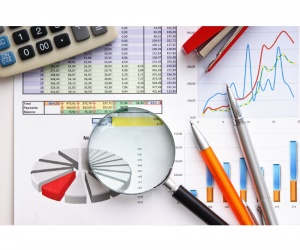With LegalTech (or should I say LegalWeek) approaching in the next few weeks, I’ve read a bunch of articles/blogs lately about legal technology trends to be on the lookout (BOLO) for in 2018. Most, if not all, of these musings have been centered on law firm and in-house counsel usage and the tech they need or will be looking to use. But I think we need a different one for what we, as eDiscovery professionals serving those law firms and legal departments, need to be focusing on for 2018. Because the two are different.
As legal technology professionals, it is our responsibility to not only think about current future trends (12-18 months out), but also to come up with the next trends (future, future trends?). We are out there looking at technology, both in the legal space and outside, and we are the ones pushing various solutions to our clients. So I‘ve put together a current future BOLO and have a few ideas on future future trends.
Present Perfect
In the next 12 months, these are the trends I think we, as the legal tech professional market, need to be watching and talking to our clients about:
Analytics, analytics, analytics for data reduction, data reduction, data reduction
 One of my friends, who is a Director at another eDiscovery company, was recently telling me about a 2nd Request her team just completed. She processed and hosted just over a TB of data and after deduping and some data analysis, they were left with ~150 GB and about 650,000 documents for review. They had 3 weeks to complete the project by the time processing was complete and wound up bringing in about 100 reviewers for the 3 weeks to blast through the process. I can’t say for sure, but I think they charged about $.85/doc for the review, plus analytics per GB charges, plus eDiscovery processing charges. And my friend said the client was super happy, as was she, that they met this unbelievably tight deadline and were able to meet all requirements.
One of my friends, who is a Director at another eDiscovery company, was recently telling me about a 2nd Request her team just completed. She processed and hosted just over a TB of data and after deduping and some data analysis, they were left with ~150 GB and about 650,000 documents for review. They had 3 weeks to complete the project by the time processing was complete and wound up bringing in about 100 reviewers for the 3 weeks to blast through the process. I can’t say for sure, but I think they charged about $.85/doc for the review, plus analytics per GB charges, plus eDiscovery processing charges. And my friend said the client was super happy, as was she, that they met this unbelievably tight deadline and were able to meet all requirements.
“So, you charged them, like, $550k for the review? For what, like, 35% production of the docs? Did you use a prioritized review (or predictive coding) workflow to get through these? Wouldn’t that have been, like, half the costs? Or less?”
And since this was a real friend, and not just an industry friend, she was none too happy with my questions or the point I was making, which was very clear: they overcharged, did too much work and really no one should be happy with the result.
My friend said that the client didn’t want to use predictive coding or a prioritized review workflow, that they wanted all the documents reviewed. Let’s just say, I didn’t buy it. I think what happened is that the client didn’t know that they could use one of those workflows, because not only would it yield similar results and be half the costs, the DOJ, FTC, SEC, etc. are okay with the workflows. Right in the request, in the guidelines for production, many US government agencies say that if TAR is used, they want certain information regarding the process and result.
Now, I get that for some matters, firms may not want to use a Predictive Coding exercise to not look at most documents or they may not want to provide the type of sampling or reporting that may be requested of them if they use one of these exercises, but there are still a bunch of different ways to use TAR that isn’t ‘not looking at docs’ that will still half the cost.
In a prioritized review workflow, you can: triage resources and have lower cost employees look at the likely not responsive – this will near split your cost for likely 70% of the documents.; you can use auto-coding and propagation to quicken/limit QC, near halving the effort it takes to complete each document by only looking at conflicts or using expansion searching to target key topics; you can use near-dupe to batch tag documents that are 90%-99% similar or more to documents you already reviewed and only QC those, reducing the number of documents you review.
My point to my friend was that there are real, impactful options out there for integrating technology and process that can have real, impactful outcomes for clients. Analytics need to become second nature to clients, and we need to help them get there. Some analytics help us reduce data volumes, some help us see patterns and relationships and some just group together similar documents in an efficient manner. We need to help our clients take advantage of all of these uses.
Matter management and its integration with eDiscovery
eDiscovery today involves a lot of documents going through a lot of different processes to ultimately get to production or to some logical conclusion point (withholding, information governance or the end of an internal investigation). A lot of work goes into these ‘finished’ documents. That’s where Matter Management comes in to play. Exhibits, transcripts, pleadings, productions and all the ancillary information around those items – case info, trial info, case contact lists, jurisdictional info – needs to be tracked and stored in a central location for all case teams to re-use the work product already done for the client or matter.
Redundant case work, especially in MDLs or long-term litigation matters, can be crippling in terms of cost, effort and scale. Clients are starting to realize, during analysis of invoice submissions alone, that setting up an integrated case management platform, that encompasses all case work, with links from each document to every other related document, is the only way to truly control costs on matters and ensure uniform litigation or defense across case teams.
Traditional eDiscovery platforms, those built for hosting and review, are not sufficient environments today to help clients control these costs as the relational database aspects are not normally embedded. As the leaders in this market, we (again the legal technology professionals market) need to be expanding our platforms to think outside the discovery phase of the litigation lifecycle and start building products that extend the use, and re-use, of all case materials. In this global and remote workforce world, we need to better understand the benefits of centralized repositories of data that allow great collaboration across teams. As an eDiscovery provider, can you link case contacts with transcripts, exhibits and produced documents to run a matrix of jurisdictional win/losses for your matter type and review the documents? I can. If you can’t, run and catch up, because more litigation is becoming serial and you won’t support clients without this relational-ability.
Visualization
 Do you choose anything these days where you don’t like the look of it? Does your heating bill have a visualization showing how you compare to your neighbors (I gasp in horror)? Does every client ask you about visual analytics? Need I even expand on this topic?
Do you choose anything these days where you don’t like the look of it? Does your heating bill have a visualization showing how you compare to your neighbors (I gasp in horror)? Does every client ask you about visual analytics? Need I even expand on this topic?
We are becoming increasingly visual consumers of information and the Legal market is no different. We’ve heard the demand, let’s respond.
Non-email Discovery
Email today is what snail mail was 10 years ago – a slow means of communication compared with the alternatives. We email for work, but when we really need an answer, we text or chat. I was in a leadership meeting a few weeks back and we decided, as a team, that most group information should be shared through chat channels, not email. Email is when you need a tracking mechanism, chat is when you need an answer.
Twitter , LinkedIn, Instagram, Slack, High Five, Zoom, Google Alerts, Waze – these are apps/items I cannot live without. I have grown accustomed to Waze telling me when to leave (planned trips), Google letting me know people are talking about me, Twitter and LinkedIn being my communication face to my peers.
, LinkedIn, Instagram, Slack, High Five, Zoom, Google Alerts, Waze – these are apps/items I cannot live without. I have grown accustomed to Waze telling me when to leave (planned trips), Google letting me know people are talking about me, Twitter and LinkedIn being my communication face to my peers.
I’ve said in in previous posts, but it bears repeating. The way we work and communicate today is so different, even from a few years back, and the eDiscovery leadership needs to stay on top of that. We need to be helping each other find all communications and documentation in all the many places we may store or post this data. Additionally, our platforms need to be able to process, host, display and produce all these various new data types as well. As methods of being in business evolve, so must legal technology.
The Cloud of Things (CoT)
 I was going to do a play on the words nimbus, cumulous and stratus (that I learned in sixth grade science) and try to do an eDiscovery equivalent but got distracted by the fact that when I searched my browser for ‘types of clouds’ the Goggle Cloud platform was the 1st hit. Interesting – guess it is of-topic – at least for Google.
I was going to do a play on the words nimbus, cumulous and stratus (that I learned in sixth grade science) and try to do an eDiscovery equivalent but got distracted by the fact that when I searched my browser for ‘types of clouds’ the Goggle Cloud platform was the 1st hit. Interesting – guess it is of-topic – at least for Google.
So, I’m talking about the IoT (Internet of Things) not the company CoT. But really, as data volumes grow, so is the accessibility of cloud storage and the real success of the IoT is the CoT accessibility. This kind of is a sub topic of Non Email Discovery, but as the way we live evolves, so must legal technology. Smart appliances, driverless cars, drones, Alexa, Siri, etc. The way we live will continue to influence the way we work, and that will then need to be supported by legal technology.
VPNs that support remote workforces, webmail, Box, remote desktop sharing – all of these are supported by cloud storage and we’ve grown to depend on them. Also, with the current focus on cybersecurity, many law firms just don’t have the ability to secure their client’s data, or their own, and are looking increasingly to cloud providers to offer them safety beyond their own means. Which means as cybersecurity legal technology providers, we need to understand current limitations and concerns, as well as anticipate new threats that we need to develop process or technology to guard against.
As our lives and work continue to move online, legal technology needs to help clients navigate the tracking, storing, securing and sharing of the new types of data we are creating every day. And as the data is being created in the cloud it seems only logical to store the data in the cloud too. And is it just me or does ‘the cloud’ seem like less of a bad word now than it was 3 years ago. I’m not sure most of know ‘the cloud’ any better today than we did 3 years ago, but it feels like we are more willing to get to know it now.
Smart sourcing
Smart sourcing, or alternative legal sourcing, continues to grow in acceptance across in-house legal counsel and within law firms. Less people are going to law school today than before the recession, and so the pool of available lawyers is dwindling. That, coupled with the ever decreasing budgets within law firm and legal departments to hire and retain attorneys, is causing the legal market as a whole to look to smart sourcing of various tasks and roles.
Legal research, document review, litigation support, contract review/management and foreign language legal anything are key areas where law firms and in-house legal alike have started to embrace the use of paralegals, legal admins, law students and in the case of foreign language, educated native speakers outside legal. The reasons for this, as I see it, are two-fold:
- Non-lawyers are paid less. And for low value work, it doesn’t make sense to pay high attorney rates.
- They can. These alternative resources have proven, in the areas listed above, that they are capable of doing the work and do it well. And when you combine that with cost, many clients are demanding this and many law firms are seeing the value for their own businesses.
This new sourcing allows us to identify the processes that are of low ROI value (sorting/coding documents, legal research, eDD processing) and carve those out for outsourcing to lower cost resources. Essentially, you take the low level work (where profits are low) and send to less expensive resources, and in doing so, alternatively keep the high value substantive legal in the law firm or in-house counsel’s hands. You put the work you want them doing in their hands and free them from the distraction of anything else. That is smart sourcing.
Future Future Tense
So that covers the current future trends I expect to see in 2018, but what about beyond 2018. What’s the buzz around the old eDiscovery watercooler of the future?
Blockchain Smart Contracts
 I know Blockchain has been talked about for a while and most people still don’t get it or know how it applies to them unless they have a cryptocurrency wallet full of Bitcoin or Ethereum. But the legal market is starting to gain an understanding for how easy contracts can be in a blockchain environment. Starting to understand. I think there is still a fair bit of learnin’ that needs to happen, but the Fintech lawyers are getting smart and talking to their colleagues and I think 2019 and 2020 will see a boon of smart contracts replacing current labored contracts (ie. old school, language written contracts). Will the likes of LegalZoom go by the wayside or will they embrace this and be a leader in helping their clients set these up? It’ll be interesting to watch that unfold.
I know Blockchain has been talked about for a while and most people still don’t get it or know how it applies to them unless they have a cryptocurrency wallet full of Bitcoin or Ethereum. But the legal market is starting to gain an understanding for how easy contracts can be in a blockchain environment. Starting to understand. I think there is still a fair bit of learnin’ that needs to happen, but the Fintech lawyers are getting smart and talking to their colleagues and I think 2019 and 2020 will see a boon of smart contracts replacing current labored contracts (ie. old school, language written contracts). Will the likes of LegalZoom go by the wayside or will they embrace this and be a leader in helping their clients set these up? It’ll be interesting to watch that unfold.
IoT and eDiscovery
More has changed in IoT in the last 5 years than ever before. I have nothing to support that, but it feels real, right? I have 9 Alexas in my house – I use them as intercoms. I also order my groceries, play music, track my kids’ whereabouts and schedule meetings through Alexa. My husband is convinced our next car will be a Tesla, and that we will use the driverless option within the next 2 years. We have a few drones that we use to deliver messages to each other in the house and they are nice enough to auto-track us and video us snowboarding or cycling. My last fridge knew when the kid’s snack drawer was light and would recommend re-ordering apple sauce or protein packs.
Imagine what the next 5 years will bring. Can you? Maybe my next fridge will do the shopping for me completely? Based on my previous orders, it can order similar food, and then, based on weight, re-order the things I am liking and not re-order the things that sat in the fridge past expiration. Maybe I will have a driverless car who knows where I work and play and automatically take me to the places I need to go. Maybe Alexa will set my schedule for me and act as a real assistant. I have no idea. All of these ideas are not too far out there – if I had a real imagination I’d be an inventor.
But as the IoT develops, again, it is going to be imperative that the legal technology market keep up. How do we discover the information captured buy these new items/tasks/abilities? How do we collect? How do we place legal holds on this information? Can we produce it or provide access? And what about privacy rights? How do they change?
Business Intelligence and New Technology
The last thing I want to mention for the future future trends is just that I think we will be spending a lot more time watching how Business Intelligence (BI) evolves. Most of the legal technology we employ today did not originate from a legal need but rather got its start from other industries and how they employed analytics to gather information. We in the legal market then found that tech and adapted it to fit our needs. We’ve done a pretty good job of this so far, but as BIG DATA grows, so will BI and it is our responsibility to find the analytics that will translate well into the legal market. More relational data analytics should be developed, more visualizations, maybe some VR?
That’s my BOLO for 2018 and beyond. LegalTech is in 2 weeks. If I see anything interesting there, I will update this list. I’d also love to hear from others what’s in their 2019+ BOLO. Call me. Let’s chat.






